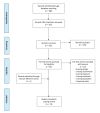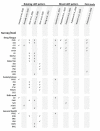Adverse Health Effects Related to Shift Work Patterns and Work Schedule Tolerance in Emergency Medical Services Personnel: A Scoping Review
- PMID: 35509733
- PMCID: PMC9060748
- DOI: 10.7759/cureus.23730
Adverse Health Effects Related to Shift Work Patterns and Work Schedule Tolerance in Emergency Medical Services Personnel: A Scoping Review
Abstract
Paramedicine as a profession is continually evolving in clinical practice, responsibilities, and workload. Changes over time in both population demographics and distribution have altered the demand for, and availability of, prehospital emergency medical services (EMS). These factors may also affect scheduling policies in many EMS organizations. However, there is little evidence that suggests optimal shift scheduling patterns to reduce adverse health events such as increased stress or fatigue in prehospital emergency health care providers. Our objective was to describe associations between variations in shift scheduling patterns and EMS provider health outcomes, such as fatigue, stress, sleep quality, and general mental and physiological health. We also sought to identify knowledge gaps. We performed searches of PubMed, CINAHL, Embase, and Cochrane databases for primary studies, systematic reviews, and meta-analyses published between January 2000 and December 2020. Studies reporting measurable health care outcomes in prehospital personnel with defined shift schedule patterns in land-based ambulance systems were included. Our search strategy yielded 188 studies, of which 11 met eligibility criteria (eight cross-sectional surveys, one single case report, one retrospective cohort study, one prospective cohort study, and one systematic review), with one additional study found through reference list screening, leaving 12 studies for review. All publications contained a description of shift schedule characteristics and shared similar outcomes of interest, although there was variation in comparators and assessment of outcomes. Most studies showed high rates of fatigue, stress, mental health concerns, and negative general health outcomes in paramedic shift worker populations. The case study reported improved fatigue, alertness, and sleep quality levels following a switch from a 24-hour shift pattern to an eight-hour shift. We did not complete an in-depth risk of bias assessment for any of the studies. Melnyk evidence ratings varied from IV to VI, indicating a low quality of evidence evaluating the impacts of shift schedule patterns in paramedics, with the retrospective cohort study design, ranked as IV, systematic review as a V, and prospective cohort study, case report and surveys ranked as VI. The low quality and quantity of evidence indicate the need for further research to definitively assess relationships between specific schedule patterns and health outcomes.
Keywords: emergency medical services; fatigue; health; paramedicine; shift work; shift work tolerance; sleep; stress; work schedule.
Copyright © 2022, Barth et al.
Conflict of interest statement
The authors have declared that no competing interests exist.
Figures


Similar articles
-
Effect of Task Load Interventions on Fatigue in Emergency Medical Services Personnel and Other Shift Workers: A Systematic Review.Prehosp Emerg Care. 2018 Feb 15;22(sup1):81-88. doi: 10.1080/10903127.2017.1384874. Epub 2018 Jan 11. Prehosp Emerg Care. 2018. PMID: 29324071
-
Beyond the black stump: rapid reviews of health research issues affecting regional, rural and remote Australia.Med J Aust. 2020 Dec;213 Suppl 11:S3-S32.e1. doi: 10.5694/mja2.50881. Med J Aust. 2020. PMID: 33314144
-
Shorter Versus Longer Shift Durations to Mitigate Fatigue and Fatigue-Related Risks in Emergency Medical Services Personnel and Related Shift Workers: A Systematic Review.Prehosp Emerg Care. 2018 Feb 15;22(sup1):28-36. doi: 10.1080/10903127.2017.1376135. Epub 2018 Jan 11. Prehosp Emerg Care. 2018. PMID: 29324079
-
Does Implementation of Biomathematical Models Mitigate Fatigue and Fatigue-related Risks in Emergency Medical Services Operations? A Systematic Review.Prehosp Emerg Care. 2018 Feb 15;22(sup1):69-80. doi: 10.1080/10903127.2017.1384875. Epub 2018 Jan 11. Prehosp Emerg Care. 2018. PMID: 29324070
-
Effects of Napping During Shift Work on Sleepiness and Performance in Emergency Medical Services Personnel and Similar Shift Workers: A Systematic Review and Meta-Analysis.Prehosp Emerg Care. 2018 Feb 15;22(sup1):47-57. doi: 10.1080/10903127.2017.1376136. Epub 2018 Jan 11. Prehosp Emerg Care. 2018. PMID: 29324083
Cited by
-
Methodological procedure based on quantitizing/liquefying: a case study to assess work climate in an emergency department.Front Psychol. 2023 Dec 22;14:1247577. doi: 10.3389/fpsyg.2023.1247577. eCollection 2023. Front Psychol. 2023. PMID: 38196562 Free PMC article.
-
Determining the relative salience of recognised push variables on health professional decisions to leave the UK National Health Service (NHS) using the method of paired comparisons.BMJ Open. 2023 Sep 12;13(8):e070016. doi: 10.1136/bmjopen-2022-070016. BMJ Open. 2023. PMID: 37699606 Free PMC article.
-
The prevalence of sleep deprivation and its impact among medical officers in a tertiary hospital, a cross-sectional study from Malaysia.PLoS One. 2024 Aug 29;19(8):e0306574. doi: 10.1371/journal.pone.0306574. eCollection 2024. PLoS One. 2024. PMID: 39208315 Free PMC article.
-
Tackling Shift Work: Cardiovascular Health in the Auto Industry.Healthcare (Basel). 2024 May 27;12(11):1097. doi: 10.3390/healthcare12111097. Healthcare (Basel). 2024. PMID: 38891172 Free PMC article.
References
-
- Shifting schedules: the health effects of reorganizing shift work. Bambra CL, Whitehead MM, Sowden AJ, Akers J, Petticrew MP. Am J Prev Med. 2008;34:427–434. - PubMed
-
- Caring for the carers: fatigue, sleep, and mental health in Australian paramedic shiftworkers. Courtney JA, Francis AJP, Paxton SJ. Australas J Organ Psychol. 2010;3:32–41. - PubMed
Publication types
LinkOut - more resources
Full Text Sources
Miscellaneous
